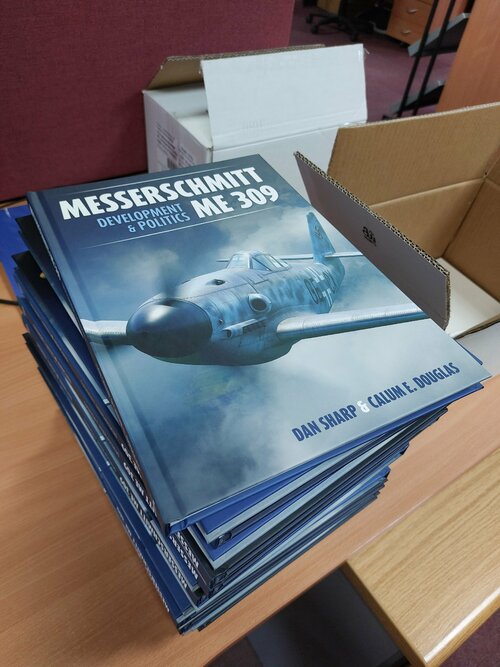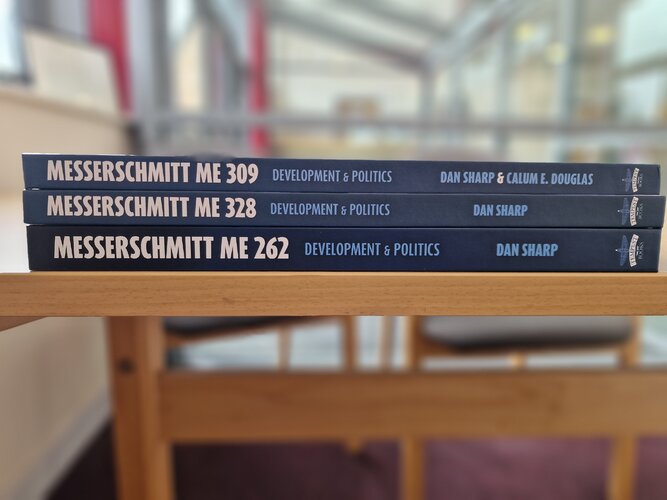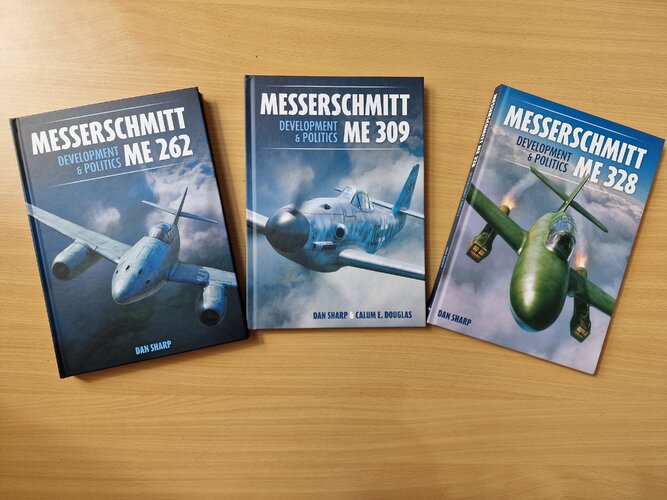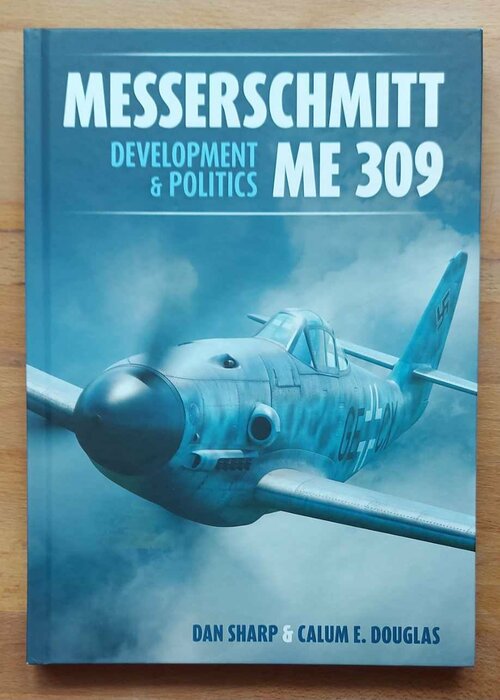Its possible without the Supermarine factory being bombed that could have happened, but thats speculation. I think a lot of Mk III stuff was destroyed.Dowding was probably in the right place to order two things:
- use the Spitfire III as day-fighter only
- revert to the 'normal' with tips as on other Spitfires
Unfortunately, Spitfire III never attained the production and service status.
You are using an out of date browser. It may not display this or other websites correctly.
You should upgrade or use an alternative browser.
You should upgrade or use an alternative browser.
Messerschmitt Me 309 Development & Politics by Dan Sharp and Calum E. Douglas
Its possible without the Supermarine factory being bombed that could have happened, but thats speculation. I think a lot of Mk III stuff was destroyed.
The MkIII stuff was mostly in front of the firewall; fuselage, cockpit and wings were the same as on the MkI/II.
The MkIII stuff was mostly in front of the firewall; fuselage, cockpit and wings were the same as on the MkI/II.
??
The wings were radically different - clipped and the plan even included boundary layer bypass radiators which were in principle like the 109F.
It was a massive redesign, in terms of design hours, ONLY the Mk 1 and Mk 21 absorbed more hours that the Mk III redesign (which absorbed double the design hours that Supermarine expended on the entire IX project)
Below from the official Vickers Supermarine Spitfire company development file.
Due in part to Dowdings complaints there were versions mooted without the clipping, which possibly explains the confusion here.
There are photos of MkIII`s which "look" like Mk 1/2 but they were never intended to be that way during design.
Note in particular fully retractable tailwheel with doors.
(I`ll go away now, I`m ruining Dan`s 309 thread...)
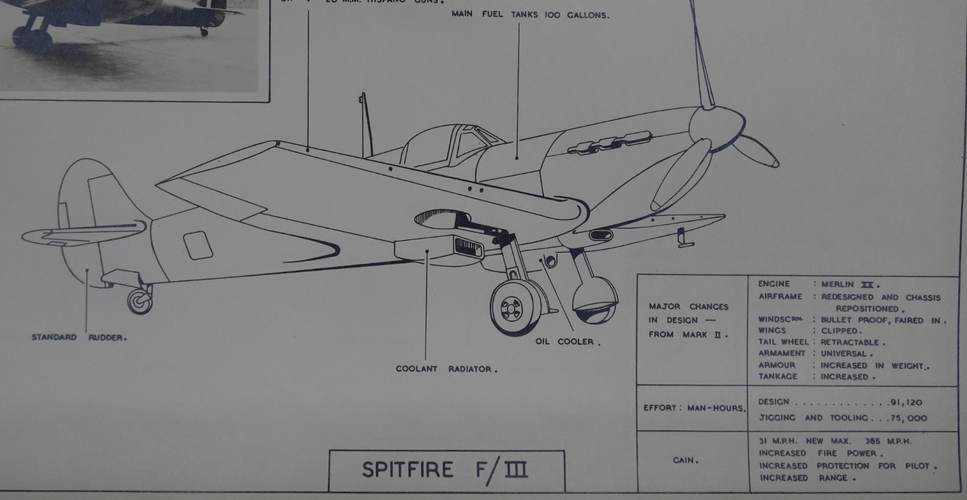
Last edited:
- Joined
- 11 June 2014
- Messages
- 1,532
- Reaction score
- 2,844
The manuscript is now finished, as of this weekend just gone. Currently adding the image captions before the book goes to the page designer.
- Joined
- 11 June 2014
- Messages
- 1,532
- Reaction score
- 2,844
I should add that the delay has been caused in no small part by unexpected difficulties with a certain engine manufacturer's archive. We eventually had to find a way of skirting around this problem in order to get the manuscript completed. But it is now complete. And we have all the images we need in hand.
It's a case, now, of doing the captions and ensuring that the images get positioned appropriately when the pages are designed.
It's a case, now, of doing the captions and ensuring that the images get positioned appropriately when the pages are designed.
I`m just inserting my images into the manuscript then its going to the page designer and then printing. The text is finished.
- Joined
- 11 June 2014
- Messages
- 1,532
- Reaction score
- 2,844
Page design work has been underway since Sunday and the first 40 pages are done. Shouldn't be too much longer till it's complete and final checks/indexing can commence.
- Joined
- 29 August 2010
- Messages
- 598
- Reaction score
- 297
I presume, then, that Amazon's currently announced release date of 29 April is impossible.
- Joined
- 11 June 2014
- Messages
- 1,532
- Reaction score
- 2,844
All editorial and design work on Messerschmitt Me 309 Development & Politics has now been completed and I have the full set of print-ready pdfs in hand. Just awaiting final details from the printer before sending it off to press.
- Joined
- 11 June 2014
- Messages
- 1,532
- Reaction score
- 2,844
I presume, then, that Amazon's currently announced release date of 29 April is impossible.
If I can send the book to the printer today, and they print it today, it might just barely be possible to have it available to post out by April 29. However, even if that isn't possible, we're not going to miss April 29 by more than a week or two.
FighterJock
ACCESS: Above Top Secret
- Joined
- 29 October 2007
- Messages
- 5,554
- Reaction score
- 5,860
So the book's arrival could slip into May possibly June Dan? I can wait.
- Joined
- 11 June 2014
- Messages
- 1,532
- Reaction score
- 2,844
The book has now been signed off at the printers and the actual printing should commence shortly. From here on, delivery dates etc. are out of my hands.
- Joined
- 11 June 2014
- Messages
- 1,532
- Reaction score
- 2,844
On amazon.uk right now it says publishing date to be 12. April but is currently unavailable at rhe same time.
It cannot be found with normal search, just when I look at my orders I can see it
Amazon are a law unto themselves. As a small publisher, you can't contact them directly - their information comes from a middleman, the distributor. The books have to go from Mortons' own warehouse to the distributor's warehouse, then to Amazon's warehouse.
There's no denying that the Me 309 book has been delayed, and for that I apologise, but 1,200 physical copies of it are about to exist in the world. It's simply a question, then, of how to get your hands on one.
- Joined
- 11 June 2014
- Messages
- 1,532
- Reaction score
- 2,844
So the book's arrival could slip into May possibly June Dan? I can wait.
As mentioned in reply #55, you can rest assured that the book is finished and is at the printers being printed - it's becoming a real physical thing and will then wend its way through to the various outlets in due course. I'm very much looking forward to having a copy of it in my hands - I might even pose it for a photo next to Messerschmitt Me 262 Development & Politics and Messerschmitt Me 328 Development & Politics, which together tell three very different sides of what amounts to the same story.
- Joined
- 11 June 2014
- Messages
- 1,532
- Reaction score
- 2,844
The printers say, in fact, that this book will ship on the same day as Messerschmitt Me 328 Development & Politics - so both will arrive together.
pathology_doc
ACCESS: Top Secret
- Joined
- 6 June 2008
- Messages
- 1,585
- Reaction score
- 1,507
(Begin David Attenborough voice.) "But Dan was to learn the hard way that books about airplanes can have the same accursed slippages in delivery as the airplanes themselves, and through no fault of the designer."If I can send the book to the printer today, and they print it today, it might just barely be possible to have it available to post out by April 29. However, even if that isn't possible, we're not going to miss April 29 by more than a week or two.
- Joined
- 29 August 2010
- Messages
- 598
- Reaction score
- 297
Not surprisingly, Amazon.com has changed the release date to 12 June. We will see.......
- Joined
- 11 June 2014
- Messages
- 1,532
- Reaction score
- 2,844
Hard copies of Messerschmitt Me 309 Development & Politics (and Messerschmitt Me 328 Development & Politics) are due to arrive in Mortons' warehouse this coming Thursday, I'm told.
Lucio
ACCESS: Restricted
- Joined
- 29 November 2009
- Messages
- 6
- Reaction score
- 17
Great! I live in Brazil and ordered the book in August of 2023.Hard copies of Messerschmitt Me 309 Development & Politics (and Messerschmitt Me 328 Development & Politics) are due to arrive in Mortons' warehouse this coming Thursday, I'm told.
Now I hope Amazon Brasil can get my copy fast.
- Joined
- 11 June 2014
- Messages
- 1,532
- Reaction score
- 2,844
Dan, you'll like this, and this isn't any kind of a comment it's just funny. So I originally ordered the 309 book back in June 2023. At that time Amazon sent me a message that they expected the release to be August 2023, then December 2023, then January 2024, then March 2024, then June 20th, 2024 -no later than 10:00 pm that night. So I kept a look out, no show. Then I got an update email around 830 pm, saying they don't know when it will be delivered they will keep me posted. Oh well.View attachment 703457
Messerschmitt Me 309 Development & Politics by Dan Sharp & Calum E. Douglas
Chosen in 1941 to replace the Bf 109 as the Luftwaffe’s standard front-line fighter, Messerschmitt’s innovative Me 309 embodied a wealth of hard-won experience from the Battle of Britain. Its sturdy tricycle undercarriage would make landings safer, its capacious wings could accommodate much heavier weaponry, its retractable radiator would make it aerodynamically clean, its pressure cabin would allow high-altitude operations and its ejection seat would help preserve the Luftwaffe’s most precious asset – its pilots.
All of this was made possible by a fuselage specifically tailored to accommodate Germany’s newest and most powerful fighter engines: Daimler-Benz’s DB 603 and Junkers’ Jumo 213. Production of up to 800 Me 309s a month had been planned by May 1942 – more than all other German fighter types combined. Yet the type’s advancement from prototype to full series production was reduced to a crawl, not by technical difficulties but by political in-fighting, deception and manipulation behind closed doors.
The Me 309 was set up to fail – doomed to join a lost generation of mid-war Luftwaffe combat aircraft alongside types such as Focke-Wulf’s Fw 190 C and Junkers’ Ju 288 – but why and by whom? Messerschmitt Me 309 Development & Politics, the first book ever written solely about this aircraft, sets out its full history – from its forerunners and commissioning to its eventual cancellation and sale to the Japanese military.
Using contemporary documents, authors Dan Sharp and Calum E. Douglas explain and explore the development and eventual failure of this fascinating ‘secret project’.
200 pages
£35
Pre-orders are now open here:
Error | Mortons Books
www.mortonsbooks.co.uk
- Joined
- 29 August 2010
- Messages
- 598
- Reaction score
- 297
Amazon is strange. I also ordered the book some months ago and had to deal with the delays, but they delivered my copy last week!Dan, you'll like this, and this isn't any kind of a comment it's just funny. So I originally ordered the 309 book back in June 2023. At that time Amazon sent me a message that they expected the release to be August 2023, then December 2023, then January 2024, then March 2024, then June 20th, 2024 -no later than 10:00 pm that night. So I kept a look out, no show. Then I got an update email around 830 pm, saying they don't know when it will be delivered they will keep me posted. Oh well.
- Joined
- 8 March 2009
- Messages
- 1,048
- Reaction score
- 1,273
The drawings of the wing list the airfoil.First question:
The Me 309 had a "symmetrical aerofoil with rather small leading-edge radius (3/4 normal NACA radius)" according to Woldmar Voigt.
Could/Does that mean the wing had a laminar flow profile?
The drawings of the wing list the airfoil.
Me 309 V1 to V4 had NACA 15014.5-0.825-37 at the wing root and NACA 15011-0.825-37 at the wing tips (p. 142).
Unfortunately I layman cannot read it (yet).
Care to elaborate on these?
Luftwaffles
I really should change my personal text
- Joined
- 1 September 2017
- Messages
- 16
- Reaction score
- 39
First of all, congratulations to Mr. Sharp and Mr. Douglas for another excellent work. Your book is a most welcome addition to my library. The thorough and well documented research you did is highly appreciated and you turned it into a comprehensive, entertaining and instructive read.
As for the airfoil discussion, i used the airfoiltools online 5 digit airfoil generator to get a plot of NACA 15014 (the modifications indicated behind the dashes are unfortunately not standard NACA nomenclature and thus not reflected in the plot). I plotted this against the P-51 D's wing root profile (according to that website's catalogue, which looks about right) using it as a stand-in for then contemporary laminar flow profiles.
I do not know what the modifiers on the Me 309 profile mean. If one of them refers to the maximum thickness position of the NACA15014, it might look more similar to the P-51 D's profile (in green).
Without taking them into account, you can see, that the Me 309 profile (in red) is a more "traditional" airfoil. Its maxium thickness occurs more upstream of the P-51 D profile, it has a slightly larger leading edge thickness and the trailing edge region is far less cambered compared to the P-51 D. All these properties contribute to the P-51 D profile being considered a laminar flow profile.
Now if Voigt's comment is accurate, one of the modifiers might refer to the leading edge radius of the NACA15014 used for the Me 309. This would push the profile more towards a laminar flow profile leading edge but it would not be sufficient for making it a laminar flow profile.
Note, that the NACA15014 can still be considered a profile geared towards higher speeds since a) the thickness is low (compare it to the P-51 D profile) and b) the camber is not overly pronounced. Also its lift coefficient of 0.15 means that it has to be flown at higher speeds in order to generate the same amount of lift as airfoils with higher lift coefficients (assuming same altitude and wing surface).
By the way, please excuse the color choice of the plot, as I could not find a way to change the standard setting.
EDIT: Using the information Sienar kindly provided below, I adjusted the Me 309 profile accordingly in XFOIL (the second attachment). The rear shift in maximum thickness combined with the reduced leading edge thickness makes it much more similar to a typical laminar flow profile. Now if only I could get XFOIL to run a proper polar...
As for the airfoil discussion, i used the airfoiltools online 5 digit airfoil generator to get a plot of NACA 15014 (the modifications indicated behind the dashes are unfortunately not standard NACA nomenclature and thus not reflected in the plot). I plotted this against the P-51 D's wing root profile (according to that website's catalogue, which looks about right) using it as a stand-in for then contemporary laminar flow profiles.
I do not know what the modifiers on the Me 309 profile mean. If one of them refers to the maximum thickness position of the NACA15014, it might look more similar to the P-51 D's profile (in green).
Without taking them into account, you can see, that the Me 309 profile (in red) is a more "traditional" airfoil. Its maxium thickness occurs more upstream of the P-51 D profile, it has a slightly larger leading edge thickness and the trailing edge region is far less cambered compared to the P-51 D. All these properties contribute to the P-51 D profile being considered a laminar flow profile.
Now if Voigt's comment is accurate, one of the modifiers might refer to the leading edge radius of the NACA15014 used for the Me 309. This would push the profile more towards a laminar flow profile leading edge but it would not be sufficient for making it a laminar flow profile.
Note, that the NACA15014 can still be considered a profile geared towards higher speeds since a) the thickness is low (compare it to the P-51 D profile) and b) the camber is not overly pronounced. Also its lift coefficient of 0.15 means that it has to be flown at higher speeds in order to generate the same amount of lift as airfoils with higher lift coefficients (assuming same altitude and wing surface).
By the way, please excuse the color choice of the plot, as I could not find a way to change the standard setting.
EDIT: Using the information Sienar kindly provided below, I adjusted the Me 309 profile accordingly in XFOIL (the second attachment). The rear shift in maximum thickness combined with the reduced leading edge thickness makes it much more similar to a typical laminar flow profile. Now if only I could get XFOIL to run a proper polar...
Attachments
Last edited:
- Joined
- 8 March 2009
- Messages
- 1,048
- Reaction score
- 1,273
Me 309 V1 to V4 had NACA 15014.5-0.825-37 at the wing root and NACA 15011-0.825-37 at the wing tips (p. 142).
Unfortunately I layman cannot read it (yet).
Care to elaborate on these?
- Joined
- 11 June 2014
- Messages
- 1,532
- Reaction score
- 2,844
But one question still remained for me, would the performance of Me 309 have been good if the development had continued and the resources were available ?
The airframe was designed to accommodate DB 603 and Jumo 213 type engines interchangably. As Calum points out, neither of these was really available in significant quantities at the point when the 309 was cancelled (Jan 1943).
However, the 213 in particular was the engine used by the Fw 190 D and intended for use with the Ta 152. It barely had chance to enter service with the 152 because... the airframe wasn't ready.
Had the Me 309 been fully backed, with all the prototypes built and tested as planned, it is possible that the airframe could have been sorted and available in quantity by the time the engine production capacity had ramped up to meet it.
The elephant in the room is probably the radiator. The Fw 190 beat the Me 209 and He 100 because it was the lowest risk option for an aerodynamically clean fighter - a nose-mounted annular radiator rather than evaporative cooling. But Focke-Wulf couldn't seem to make it work properly. 190s kept overheating to the point where the 801-powered variant was deemed a failure and was scheduled for low numbers production then cancellation. The annular radiator was deemed a failure - so the 309's combination retractable radiator and evaporative cooling looked attractive.
But then Focke-Wulf sorted the cooling problem. They figured it out and the annular radiator came to be viewed as a very effective low-drag way of keeping the engine cool. Therefore, when Messerschmitt were working out the 109/213 (second Me 209) they specced it with an annular radiator - the development of which was already done - rather than the underdeveloped system planned for the 309. Could the 309 have taken an annular radiator? Probably not without major changes.
So a fully-funded, full-commitment mass-production Me 309 may well have had good performance, but it might also have been held back by its complicated radiator arrangement.
Once again I would like to thank you for the great book, the one about Me 262 I also plan to buy.
Can I ask about the Me 309 speeds and their testing ? The book states that the Me 309 was faster by about 20-50 km/h ( depending on the place in the book) than the Bf 109G. So was it tested with the engine giving full power and the radiator retracted and the aircraft at full " production" weight ?
Can I ask about the Me 309 speeds and their testing ? The book states that the Me 309 was faster by about 20-50 km/h ( depending on the place in the book) than the Bf 109G. So was it tested with the engine giving full power and the radiator retracted and the aircraft at full " production" weight ?
- Joined
- 11 June 2014
- Messages
- 1,532
- Reaction score
- 2,844
Once again I would like to thank you for the great book, the one about Me 262 I also plan to buy.
Can I ask about the Me 309 speeds and their testing ? The book states that the Me 309 was faster by about 20-50 km/h ( depending on the place in the book) than the Bf 109G. So was it tested with the engine giving full power and the radiator retracted and the aircraft at full " production" weight ?
There's a little bit to unpack here. Sure you can ask about the Me 309 speeds and their testing but you won't get the answers that you want - because, as we've tried to explain in the book, the Me 309 test schedule barely got started. Only one prototype was tested for any length of time and it was primarily used for undercarriage and centre of gravity testing - not outright speed tests (some speed testing with different radiator settings was done on November 7, 1942, but the results are sadly unknown).
You say 'the book states' that the Me 309 was faster than the 109 G by about 20-50km/h - depending on the place in the book. To be more specific, the book - the authors - doesn't/don't state that, rather, the book directly reports what is said about the aircraft in primary source documents - in this case flight test reports and stenographic records of high-level German air ministry meetings.
In Chapter 4, we quote directly from Beauvais' test flight report: “General. Me 309 V1 was flown from 20.11.42 to 23.11.42 with 3,585kg [take-off weight] and 17% [centre of gravity] and with 3,815kg and 23% centre of gravity by the [Luftwaffe] test centre (Beauvais). The re-testing was incomplete, since bad weather prevented above all the verification of the stalling behaviour and the achievement of the provisionally approved maximum top speed of 650km/h.”
Note the text in bold. Beauvais was unable to test the Me 309 V1's top speed when flown against the Bf 109 G due to bad weather. No direct in-flight speed comparison appears to have ever been made. So the question, in this instance, of whether the engine was giving full power, whether the radiator was retracted and whether the aircraft was at full 'production' weight isn't really applicable.
But during the tests Beauvais was able to conduct, the prototype DB 603 fitted to the aircraft wasn't directly comparable to a refined production model DB 603. The radiator position during these tests is unknown. Beauvais states that automatic adjustment was missing and there was no radiator status display. This suggests that manual adjustment in flight was possible. He would have had to keep the radiator open during take-off and climb, but did he attempt to close it and try for a speed run? It doesn't sound as though he did. Was the aircraft at full 'production' weight? No. The maximum take-off weight for the production model is given as 4,240kg (Messerschmitt data sheet of October 26, 1942, see Chapter 4). Beauvais tested it at 3,585kg and 3,815kg.
Then in Chapter 5, which includes the figures you reference, there is a quoted section from the stenographic record of a meeting on December 29, 1942:
Friebel: “The speed is higher!”
Milch: “By how much?”
Friebel: “50km/h higher!”
Milch: “For fighter planes, the jump we always strive for has been reached again with the 50km/h. On the other hand, you must comment on the question of climbing ability! Why does the machine have a worse rate of climb? Does that mean it will actually have a worse rate of climb [in service], or was that just the first tests?”
Friebel: “No, it will undoubtedly have a worse rate of climb. I recorded the rate of climb curve here.”
This is a conversation. Where did Friebel get his figure from? What was his documentary/test evidence to back it up? Don't know. Do we know what the state of the aircraft was in whatever source Friebel was using as his evidence? No.
Lastly, at another meeting on February 22, 1943, after the Me 309's cancellation, Edgar Peterson, head of the Luftwaffe test centres, says: “We had various comparison flights, first in Augsburg, where it turned out that the 309 is 20 to 30km/h faster than the 109 in terms of speed, and about 10 to 15% worse in terms of climb performance."
The comparison flights were presumably those conducted by Beauvais from November 20-23. Beauvais was conducting the tests on Petersen's orders. It's not impossible that other flights were made, but if so we don't have any details of them nor even passing references to them. Where does Petersen get his '20-30km/h' figure from? Again, we don't know exactly. We do know that Beauvais was unable to conduct a speed comparison.
I would guess that both Friebel's and Petersen's figures, if they're not just guesswork, are based on calculated performance rather than actual performance. Did those calculations, when they were made, account for the power level of the engine, status of the radiator and weight? Probably. But we don't know for certain. Did Friebel and Petersen use the same parameters/calculations as one another to reach those slightly different figures? Don't know.
So was the Me 309 cancelled without anyone ever conducting a thorough speed test of the Me 309 V1 versus a Bf 109 G? I would say so, yes, since there is no known evidence to the contrary.
The bottom line is, the Me 309 programme never really reached a point where proper testing could be conducted.
Last edited:
- Joined
- 19 July 2016
- Messages
- 4,243
- Reaction score
- 3,428
Before I came to this site, I had little inormation on the 309, the opinions were split between being slower than the 109 and a slight increase in speed over the 109 meaning there was nothing to be gained.
Diverse opinions with no data to back the theories up.
Looking at the radiator issues, could they have used a P-51 type setup? Pretty sure they knew at least something of the phylosophy behind the tech involved. I suppose it depends on when they became aware of such a design.
Diverse opinions with no data to back the theories up.
Looking at the radiator issues, could they have used a P-51 type setup? Pretty sure they knew at least something of the phylosophy behind the tech involved. I suppose it depends on when they became aware of such a design.
pathology_doc
ACCESS: Top Secret
- Joined
- 6 June 2008
- Messages
- 1,585
- Reaction score
- 1,507
Order was placed at Amazon today. I could not resist a book that discusses in lurid detail how the politics of a procurement process make an aircraft fail, and having Calum on board as well was just the icing on the cake that was the BUY button.
- Joined
- 19 July 2016
- Messages
- 4,243
- Reaction score
- 3,428
On first blush the print is a bit feint for my taste but I am due new optics so I suppose it could be a simple resolution.
That various sites, (Amazon for the most part) list Callum as the author did curdle my milk tbh. Credit where it is due and there are two very fine educators involved rather than one.
That various sites, (Amazon for the most part) list Callum as the author did curdle my milk tbh. Credit where it is due and there are two very fine educators involved rather than one.
Similar threads
-
Messerschmitt Me 262 Development & Politics by Dan Sharp
- Started by newsdeskdan
- Replies: 152
-
Luftwaffe: Secret Designs of the Third Reich
- Started by newsdeskdan
- Replies: 173
-
Luftwaffe: Secret Projects of the Third Reich by Dan Sharp
- Started by newsdeskdan
- Replies: 183
-
Secret Projects of the Luftwaffe by Dan Sharp
- Started by newsdeskdan
- Replies: 49
-
Secret Projects of the Luftwaffe: Blohm & Voss BV 155 by Dan Sharp
- Started by newsdeskdan
- Replies: 68

